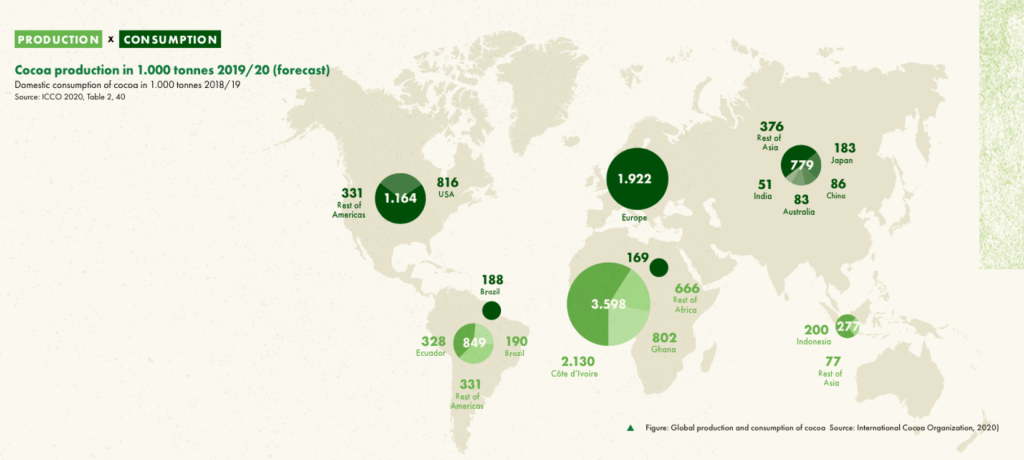This impact story was originally posted in TFA Perspectives here.
Chocolate’s impact on nature and society has been – in the words of WWF – “bittersweet”. In West Africa, which produces three-quarters of the world’s cocoa beans (see figure on the next page), the industry has long been linked with deforestation and child labour. According to the Tropical Science Journal and Vivid Images database, cocoa is the key driver for 90% of illegal deforestation in Côte d’Ivoire , while within the past decade an estimated 2 million children have been used for hazardous labour associated with growing, harvesting and transporting the crop in the region.
Yet it doesn’t have to be this way. As the Tropical Forest Alliance (TFA) reports in its recent publication Amazon Origin Sustainable Cocoa, when farmed sustainably, cocoa can become part of the solution to preserve and restore forests. Using an agroforestry approach, cocoa brings a wide range of benefits, including not only carbon capture, but also rebuilding biodiversity, preserving soil moisture and fertility and stimulating rainfall.

The challenge is to unlock the investment to make genuinely sustainable cocoa farming a realistic option for cash-strapped growers. In Latin America, for example, 95% of cocoa beans are produced by millions of smallholder farmers and Indigenous people.
For the past three years, TFA has been convening public-private dialogues in Brazil, Colombia and Peru to promote the sustainable production of cocoa that can command a premium price. The good news is that, compared to cattle ranching, incomes for smallholders can be six times higher when producing cocoa this way. Initiatives like the Cocoa and Forest Initiative in the Côte d’Ivoire, Ghana and Colombia are working with multiple stakeholders to end deforestation. Private sector action is also noteworthy, in Asunafo- Asutifi landscape in Ghana multiple stakeholders including eight commodity companies have joined efforts to produce cocoa sustainably.
There has been promising progress on the demand side too. On 28 June 2022, the European Union – the world’s largest importer of cocoa beans – along with Côte d’Ivoire, Ghana and the cocoa sector endorsed an “Alliance on Sustainable Cocoa”. The initiative aims to channel resources to cocoa farmers in the region – many of whom live on or below the poverty line – to tackle deforestation and child labour while boosting livelihoods.
What do you see as the most important emerging trend, concern or solution for the sustainable production of cocoa?
Adopt a landscape approach to sustainable cocoa production – Abraham Baffoe, Africa Regional Director Proforest
Worldwide, 90% of cocoa is grown by smallholders, who – for lack of resources, capacity and expertise – practice “slash-and-burn” and expansion of cocoa into forest lands to increase production. This approach to farming not only affects the long-term productivity of the crop, but also makes cocoa a major driver of deforestation, particularly in West Africa which accounts for 75% of global production.
To address this and bring cocoa production onto a sustainable path, TFA Africa has initiated a collaboration with governments, private sector companies and other stakeholders on a landscape approach to addressing deforestation and cocoa productivity, focusing on avoiding expansion into forestlands, supporting farmers to adopt agroforestry practices that improve tree cover in cocoa farms as well as promoting biodiversity and healthy ecosystems. We strongly believe that the landscape approach has potential not only for long-term sustainable production of cocoa but also improved income and livelihoods for smallholder farmers.
Invest in high-quality, farmer-centric agroforestry revolution – Etelle Higonnet, Environmentalist and Cocoa Sustainability Expert

Monoculture plantations have replaced what used to be richly forested biodiversity hotspots. Today, one key solution for re-greening the cocoa industry is for monoculture farms to transition to agroforestry, in all or most of the cocoa-growing regions worldwide.
However, top-down agroforestry isn’t the answer. We need farmer-centric agroforestry transitions that first help farmer food security, second provide for farmer income diversification, and third revitalize biodiversity – with the added benefit of sequestering a lot more carbon. Without farmer support and even enthusiasm, agroforestry programmes tend to be doomed to failure. That said, doing agroforestry “well” is harder and more expensive than doing low-ambition, poor-quality, “hit and run” agroforestry.
So going forward it will be crucial to mobilize large-scale finance through carbon “insetting” [a company offsetting its emissions through a project within its own value chain] and other creative solutions, to help the industry make an agroforestry revolution financially viable. For more reading of peer-reviewed papers on cocoa agroforestry in different languages, check out the Smithsonian’s and Mighty Earth’s Collaboration: the Cocoa Agroforestry Library.
Promote a living income from cocoa to encourage young people to keep farming – Osei Kwame, Country Director Ghana, Rainforest Alliance

The global cocoa market recorded a revenue of over $12.5 billion in 2021 and this is projected to hit over $16 billion by 2028. In addition, the chocolate industry is expected to have a market retail value of $190 billion by 2026. However, just a tiny percentage of this staggering revenue reaches the 5-million-plus smallholder producers worldwide. Many of these farmers’ earnings are below the living income line.
As the concept of a “living income” is now an emerging trend in leading cocoa-producing regions, it is imperative to grow the share of revenue that reaches these numerous smallholders. Increasing cocoa prices at the global level and curtailing the soaring prices of farm inputs will help smallholder farmers earn more from the global cocoa trade. Moreover, diversifying farmers’ income streams will make them more resilient against both market and climatic shocks. We also believe our quest at Rainforest Alliance to promote a living income will influence more young people to stay in cocoa farming.
Show farmers how climate-smart agriculture can reduce negative impacts and boost livelihoods – Andrew Brooks, Head of Cocoa Sustainability, Olam International

Cocoa farmers are hugely vulnerable to climate change. The impact of unpredictable weather patterns means many struggle to earn enough from their crop. Yet emissions from cocoa production also contribute to the problem. We know that one way to address these interlinked challenges is through climate-smart agriculture, which helps reduce emissions and increase productivity. The question is, how do we convince more farmers to adopt it?
It turns out that seeing is believing. At Olam International, we employ young adults from the local community and train them in good agricultural practices and services. We help farmers to apply climate-friendly techniques such as agroforestry, pruning and organic composting to an acre of their land, with the labour costs shared between Olam Group and our customer partners.
By seeing the benefits of proper farm management first-hand, farmers are encouraged to work with Olam Group and partners to transform their whole farms in this way. This in turn creates a positive ripple effect as others realize that this approach could help make their businesses more resilient to climate change. Delivered at scale, climate-smart agriculture really can turn farmers into agents of positive change in a way that works for them and the planet.
Pay smallholders to conserve forest, while scaling up agroforestry and cocoa productivity – José Yturrios Padilla, Director, Peru Cacao Alliance

The growth of such small-scale agriculture has been more forest-intensive than technology-intensive, since the forest has been the most abundant and least expensive resource in many cases.
At the Peru Cacao Alliance, we believe that the solution to produce sustainable and climate-resilient cocoa in Peru is to value the natural capital that these small producers create or maintain on their land – especially its role in mitigating climate change through, for example, carbon sequestration and emissions reductions.
Our strategy has three key components:
- Scale-up agroforestry systems with small producers, greatly increasing the number of timber and fruit trees in the 230,000 hectares of cocoa that exist in the Peruvian Amazon.
- Conserve and enrich the 600,000 hectares of forest that lie within the farms of the 90,000 smallholder producers of cocoa in Peru – promoted through the replication of payments for ecosystem services.
- A deep injection of technology that increases productivity per hectare and thus reduces the pressure to cultivate in new areas of primary or secondary forest.
